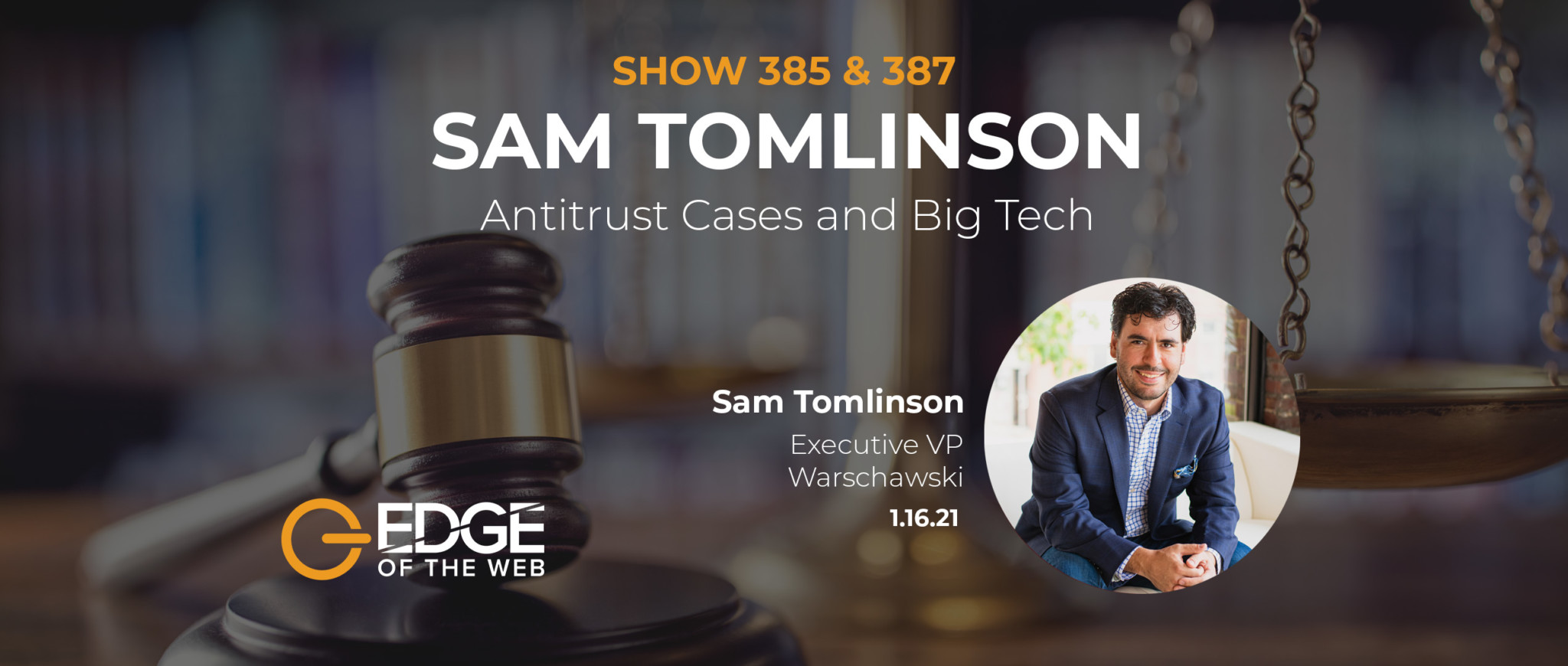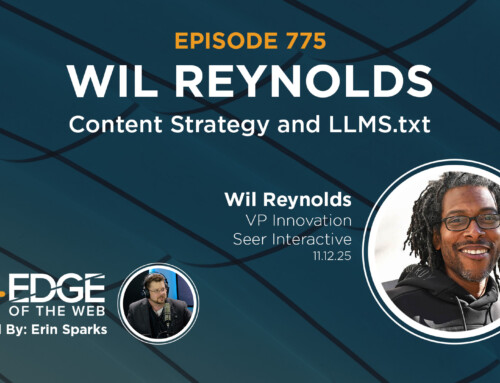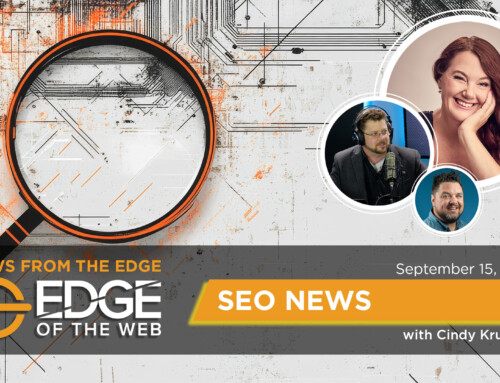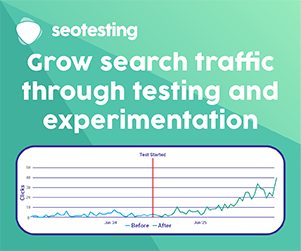Our special guest for episode 385 of the award-winning EDGE of the Web podcast was Sam Tomlinson, Executive Vice President at Warschawski. In the first part of this interview, host Erin Sparks spoke with Sam about what all this anti-trust talk is about, as well as the need to define what turns out to be a very complex set of issues involving trade-offs. Here’s what we learned:
Sam Tomlinson: His Background and Experience
Sam Tomlinson is Executive Vice President at Warschawski. Sam oversees client accounts and is responsible for both the strategic direction and execution of all integrated digital marketing and data analytics initiatives. Sam has more than seven years of experience in business and data analytics, digital marketing and strategy. He currently serves as Warschawski’s EVP and head of the Digital and Analytics teams. Since joining Warschawski in 2015, Sam has helped build and train the agency’s growing digital team, while leading digital programs, campaigns and analytics solutions for many of the agency’s largest clients. Sam is a member of the Digital Analytics Association and a frequent columnist for some of the industry’s leading publications, including Marketing Insider, Convince & Convert, and Duct Tape Marketing. He’s also active on the digital marketing speaking circuit, including events such as SMX, most of which are currently happening virtually due to the pandemic.
Warschawski is a full-service marketing communications agency with headquarters in Baltimore and offices in both New York and Washington, DC. They work with clients all over the globe from Series A startups to public companies to hone their marketing strategies and campaigns. On the digital side this includes paid search, paid social, programmatic display, video, conversion rate optimization, landing page development, web development. And all the traditional marketing channels as well (television, public relations, creative, and so on). It’s a fully integrated operation.
The Rise of Anti-Trust Lawsuits Against Big Tech
Federal regulators and state attorneys general have expressed growing unease about the unchecked power of the technology giants. But they also struggle with how to bring a case because of the complexity of the companies and the markets they competed in. For two decades, while the biggest technology companies amassed more power, branched into new businesses, and gobbled up competitors, US regulators have mostly exercised restraint in enforcing antitrust laws. Now the lawsuits are starting to come, and they argue these firms are harming consumers, but it’s not an easy argument to make given the complexities. But what exactly is anti-trust?
Back when antitrust became a topic of concern back in the 1800s, the word “trust” was just a synonym for “big business.” The anti-trust movement was a way to hold big companies accountable and regulate them in a way to promote competition for the benefit of consumers. Microsoft got hit with antitrust legal actions for going too far in bundling (i.e., forcing) its own apps such as its web browser with its hugely popular Windows operating system for PCs. Now today we have even bigger tech giants such as Amazon, Apple, Google, and Facebook. And the anti-trust actions are unfolding on global stage, such as the EU taking on Amazon. Here in the US 48 attorneys general and the Federal Trade Commission have gone after Facebook, and now there’s recent cases being brought against Google’s parent company, Alphabet, by the Justice Department. So what’s behind the rise of this new wave of anti-trust actions against big tech?
Sam notes that the way big tech has literally exploded in such a short amount of time is completely unprecedented in the history of capitalism. Anti-trust action is meant to ensure markets are free and functional. Back in the early 1990s tech companies were minor players at best, but by 2010 they had become the backbone of the economy. Think of all the other industries that are so heavily regulated. As they grew over the decades, regulations to keep them in line were developed.
But this has not happened with big tech, which grew to juggernaut status in a short period of time without much of anything in the way of regulatory frameworks being developed alongside it. In part this is because regulators don’t understand big tech, they don’t know what to do about it, they want to leverage it for their own ends, but they also don’t want to get screwed by it. As a result, nothing happened and suddenly big tech is absolutely huge. Now people are panicking about how much power those companies have and are trying to rush to do something about it.
Part of the problem is how whatever kinds of anti-trust laws are on the books are far too archaic to deal with the complexities of big tech today. The US has the Sherman Act of 1890, the Clayton Act of 1914, and the Federal Trade Commission Act of 1914. How can these laws possibly have any effective bearing on the big-tech companies of today? Interestingly enough, the EU takes a different approach. Instead of trying to figure out how to apply old laws to new situations, if they find something they don’t like, they make new laws to deal with it. And the European model arguably has gotten better results when it comes to anti-trust actions.
Getting Clear on the Complexity of the Problems
The range of concerns about big-tech companies revolves around lack of competition, user privacy, and dealing with misinformation. In the big picture, each company is an entire ecosystem that is in charge of selling advertising on the platform it controls and you have to play in their sandbox because they control so much of the market.
What Sam thinks people lose sight of is how complex this problem is, and how many trade-offs are involved. As H. L. Mencken once put it, “For every complex problem there is an answer that is clear, simple, and wrong.” Just taking a hammer to these companies and breaking them up would be clear, simple, and wrong. Doing nothing would be clear, simple, and wrong. What we’re left with is having to deal with difficult trade-offs, such as the trade-off between security and privacy, the trade-off between scale and user affordability (a bigger scale is cheaper), and so on.
There’s also the issue of clarifying what are the actual problems that need to be solved, and the lawsuits so far aren’t especially clear on this. Is it about Big Tech being mean to other Big Tech companies? No. Is it about Big Tech being mean to other companies? Yes, that’s the competition problem. Is it Big Tech being mean to consumers? Yes, that’s the privacy problem. Are we talking about the ways bad people use tech? That’s the misinformation problem. Notice that not all these problems are about competition. Some are straight-up regulatory problems, and some are human problems (misinformation).
More and more people are thinking about Big Tech companies and the internet as a utility, just like electricity or how phone companies used to be because they’re both ubiquitous and essential to society. Think about how the internet and the big-tech companies that run it saved many a company and livelihood just because of having Zoom and other video conferencing apps available. This just adds another layer of complexity—how dependent we are on Big Tech.
Connect with Sam Tomlinson and Warschawski
Twitter: @DigitalSamIAm (https://twitter.com/DigitalSamIAm)
Sam’s Website: https://samtomlinson.me
Warschawski Twitter: @thewagency (https://twitter.com/thewagency)
Warschawski Facebook: @thewagency (https://www.facebook.com/thewagency)
Warschawski LinkedIn: https://www.linkedin.com/company/warschawski
Warschawski Website: https://www.warschawski.com
Connect with Erin Sparks, Host of EDGE of the Web and CEO of Site Strategics
Twitter: @ErinSparks (https://twitter.com/erinsparks)
LinkedIn: https://www.linkedin.com/in/erinsparks/






















